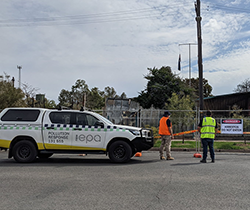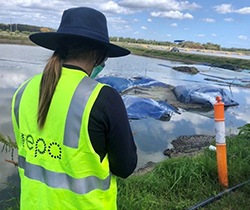Around the regions
An iconic Bourke building fire site asbestos assessment in the west, marine pollution spills in the north and south, fines for buried tyres in the north west and consultative committee action in the Hunter - we bring you news of initiatives and action from around our regions.

Aerial shot of the fire site
EPA attends iconic Bourke building fire site
A landmark building in Bourke Western NSW, the Diggers on Darling, was tragically destroyed by a fire in September, requiring the EPA to attend to assess the environmental impacts and health risks.
Joshua Loxley from the EPA’s Dubbo Regional Office assisted Fire and Rescue NSW and Bourke Shire Council to manage fire-affected asbestos waste to protect the local community. He inspected the site and advised on the waste disposal as the debris was suspected, and then found to have asbestos in it.

The EPA were called to asses for asbestos risk
“It is always sad to see a cultural and historic loss from an incident like this, especially at a time when COVID-19 is creating anxiety and challenging the community,” Joshua said.
“However, the most important thing for us was to make sure there was no harm from contaminants in the aftermath of the fire, and that the site had been secured, ready for the waste to be disposed of at Bourke Waste and Recycling centre.”
The Digger on Darling was an institution in the Bourke community and housed irreplaceable local area war memorabilia.

EPA inspects diesel oil spill near Narooma
Spills on north and south coasts threaten marine life
EPA officers were ready to respond and provide their expertise and advice on the containment and clean-up of a diesel oil spill at Wagonga Inlet near Narooma on the South Coast in August.
NSW Fire and Rescue contained the spill and EPA staff liaised with other agencies and the oyster growing community, to ensure the surrounding oyster farms were protected from the oil spill.
“Coming into the summer months, the demand for oysters will increase significantly so it’s also a relief for these farmers that their produce is safe,” EPA’s Matthew Rizzuto said
In another, smellier incident, the EPA has directed Ridley Agriproducts to clean-up fish waste sludge that spilt from a storage bladder at its Palmers Island site near Yamba on the north coast. Fortunately, the local waterways were not affected by the 5,000-litre spill.
Report pollution to Enviro Line on 131 555.

Coal mines in the north west were fined for stockpiling and burying truck tyres
North western coal mines cautioned for burying tyres
The EPA issued Official Cautions to six open cut coal mines in the Namoi and Liverpool Plains regions following an investigation into the burial of waste haul truck tyres.
Director Regulatory Operations Stephen Budgen said while the EPA did not find evidence that these tyres were brought onto the mine sites from other areas, the investigation identified that all six mines had buried their tyres without the necessary licence conditions.
Stephen said an Official Caution was a regulatory tool used to encourage compliance and help improve environmental outcomes.
“The EPA is also actively engaged with the mining and tyre recycling industries to find long term strategies for the management and safe disposal of their waste tyres,” he said.
Mining operators can find out more about safe tyre disposal or call the Environment Line on 131 555 if they have concerns
Hunter community consultative committees in motion
Two important community committees continue to highlight and address environmental issues in the Hunter.
The Newcastle Community Consultative Committee on the Environment (NCCCE) met recently to discuss the Hunter Estuary study, as well as the impacts of water pollution, ash dams and transport pollutants in the Newcastle local government area.
Meanwhile, the EPA called for nominations from local industry and environment groups to join the Hunter River Salinity Trading Scheme Operations Committee, with membership up for renewal.
Executive Director Regulatory Operations Carmen Dwyer said the Trading Scheme is world-leading in its use of economic incentives to effectively protect the local river and “since it started in 2002, it has been responsible for restoring the waters of the Hunter to an unprecedented level of health.”
Find out more
- See the full list of NCCCE members , previous meeting minutes and presentations.
- About the Hunter River Salinity Trading Scheme
- About the Upper Hunter Air Quality Advisory Committee

